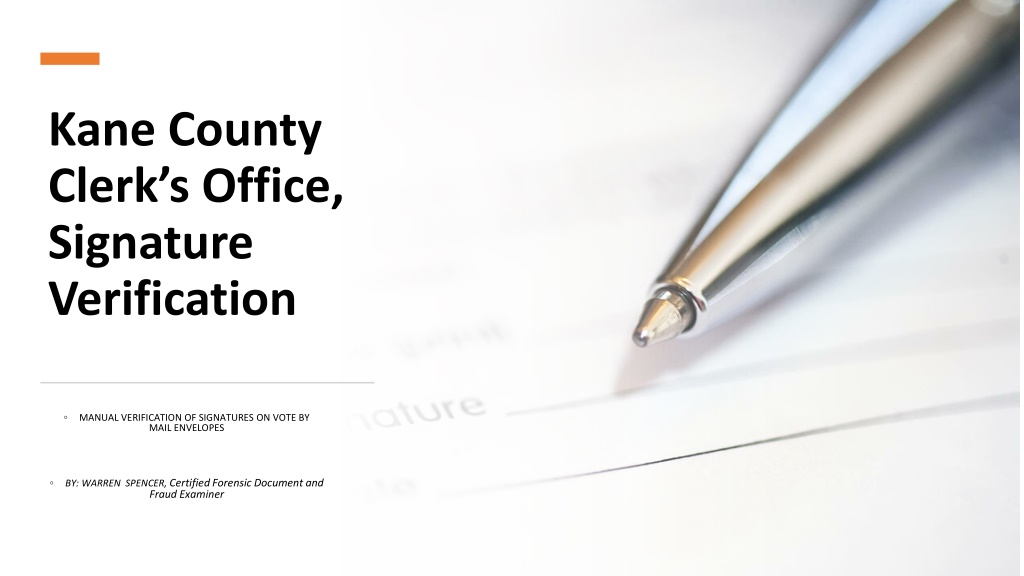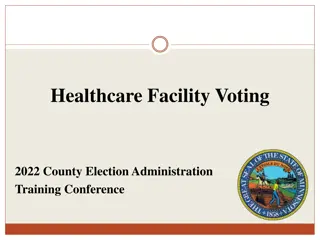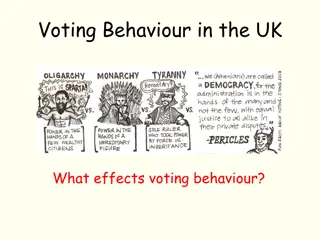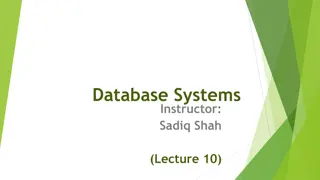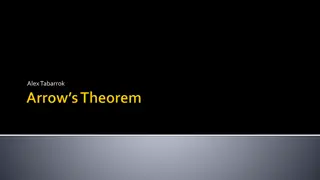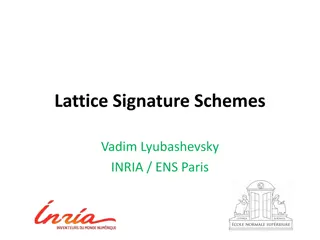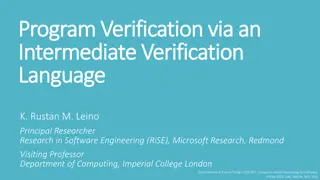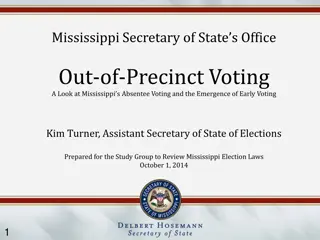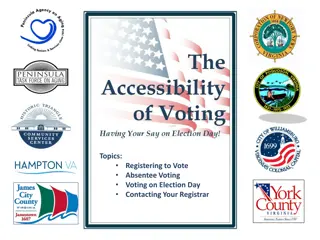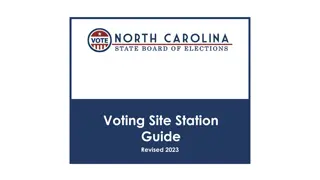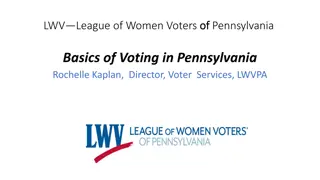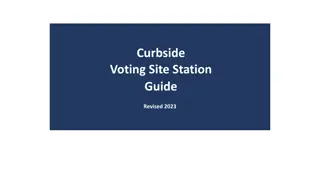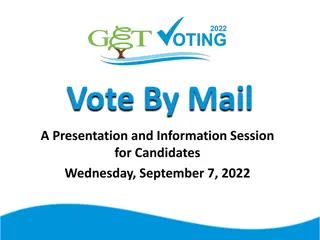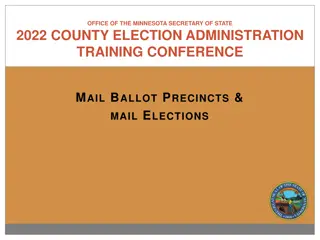Ensuring Integrity: Signature Verification in Mail-In Voting
Kane County Clerk's Office employs certified forensic document examiners for manual verification of signatures on mail-in ballot envelopes, emphasizing the challenges and importance of ensuring authenticity in the voting process. Learn about the technology and processes involved in signature authentication, the significance of election judges' role in maintaining public trust, and the distinction between genuine, authentic, suspect, and challenged signatures.
Download Presentation

Please find below an Image/Link to download the presentation.
The content on the website is provided AS IS for your information and personal use only. It may not be sold, licensed, or shared on other websites without obtaining consent from the author. Download presentation by click this link. If you encounter any issues during the download, it is possible that the publisher has removed the file from their server.
E N D
Presentation Transcript
Kane County Clerk s Office, Signature Verification MANUAL VERIFICATION OF SIGNATURES ON VOTE BY MAIL ENVELOPES BY: WARREN SPENCER, Certified Forensic Document and Fraud Examiner
Voting by Mail is easy but presents Voting by Mail is easy but presents unique challenges. unique challenges. 1. The voter is not present when 1. The voter is not present when casting their Ballot. casting their Ballot. 2. Election Judges can not 2. Election Judges can not visually identify the voter and visually identify the voter and converse with them. converse with them. 3. The signature on the Ballot 3. The signature on the Ballot Return Envelope is the only Return Envelope is the only means to determine if the voter means to determine if the voter is actually the person casting is actually the person casting the ballot. the ballot. 4. Election Judges will be 4. Election Judges will be reviewing a high volume of reviewing a high volume of signatures as VBM Ballots are signatures as VBM Ballots are processed. processed.
Technology has assisted in the election process. High speed equipment has been introduced to aid in efficiency and accuracy of the election process. Important to build Public Trust Scanners captures images of the signature. However it does not authenticate signatures. A bi-partisan team of trained Election Judges must view and authenticate each signature together.
Election Judges Course in Signature Authentication
First, a brief Vocabulary lesson We do not say Forgery. Forgery is a crime that consists of intent to defraud by misrepresentation. Only a judge in our court system can deem if this situation is a crime, and what someone else gains by this misrepresentation. We can still make the handwriting inspection. Instead of using the word forgery , we can determine if a signature is Genuine or Authentic and written by the person that owns that name. Or, we can determine the signature is Suspect or Challenged meaning that the owner of that name may not have created that signature.
Natural Variance in Signatures Suspect Suspect: FACT: People do not sign their signature the same way every time. Signatures change over time and in different settings. BUT the Basic Elements of their signature never changes
Compounding Issues with Signatures on Record Today, voter registrations and Department of Motor Vehicles ask you to digitally sign your name with a stylus. Some devices do not let you see your signature as you sign it, and that presents visual disturbances. The digital Signature can be different from a wet ink on paper signature. This presents difficulty in determining if a signature is genuine and sometimes results in challenged ballot submissions.
The Signature Class Teaches General Information about signatures Principles and Theories about Signature Analysis Various types of Forgeries Signature Variables Determining Authenticity: Identifying Broad Characteristics Identifying Local Characteristics
A signature is the most common thing a person writes in their lifetime. You don t have to think about Creating a Signature as it is a remote discipline. You sign your name over and over, to the point it becomes largely a habit. However, for as often as you sign your name, no two signatures are ever Identical. If they are, they are copied (forged signatures.) There should always be very slight natural variations in each sample. Still, the basics of the signature remain consistent.
No Rules There are no rules with respect to writing a signature, so they are open for being highly individualized. In the state of Illinois, we accept: printing, cursive, print-script and Marks However, this Signature or Mark or style must remain consistent with what is on file for the writer.
Everyones writing is Unique Because everyone s signature is personal and individualized, Signatures are identifiable and legally binding.
Yes! Signatures do change over a lifetime. Temporary changes may be due to an event (such as an auto accident, or assault, broken arm, etc.) or due to medical or chemical events in the body (alcohol, drugs). Age does take its toll on the body, just as does extended health issue. Tremors, micrographia, and variable pressure are common in this instance. Do Signatures Change?
#1 Physical Influences; Age, Health, Injury, Fatigue, Chemicals Hand/Eye Coordination #2 Mechanical Influences; Paper, Writing Instrument, Writing position Writing Surface, Guided hand #3 Psychological Influences; Factors that affect Handwriting: Trauma, Anxiety, Duress
Principles and Theories Genuine Signatures Natural line quality, rhythm and movement Beginning and Ending strokes are tapered Smooth Letter Connections Each segment of the signature flows naturally to the next
Principles and Theories Non-Genuine Signatures Disrupted line quality, rhythm & movement Hesitant, jerky, shaky, Drawn Blunt beginnings and ending strokes Angles instead of rounded curves Pen-lifts and or pauses between segments of signature
Principles and Theories Signature Variables Normal changes occur in everyone s writing or signature. Some variations within a person s signature is one indication of genuineness.
Principles and Theories Signature Variables over Time
Principles and Theories Pictorial Appearance of Signatures The overall effect or look of the signature The initial impression the first to strike one s eye Making the signature immediately recognizable Governed by size, slant, arrangement, spacing, degree of simplification or elaboration, etc.
Types of Forged Signatures Simple Forgery Simple Forgery Simple Forgery is just signing another s name. There is no intent to imitate the authentic signature
Types of Forged Signatures Simulation Simulation Simulation is making a free-hand imitation of a signature (essentially a drawing of someone else s signature)
Types of Forged Signatures Transferred Signature This is the classic Cut and Paste . Some forgers actually cut and paste and then make photocopies to eliminate the edges of the paper; or a digital cut and paste from document to document.
Types of Forged Signatures Traced Forgery Traced Forgery is using the original signature as a template and then they actually trace the signature.
To consider a signature as genuine: There must be: Significant agreement between the questioned and known signatures. And, NO unexplainable differences.
There must be: Significant agreement between the questioned and known signatures. And, NO unexplainable differences. So, what is an Explainable difference: Age Medication Injury or Illness Recent Trauma Guided Hand
To consider a signature NOT Genuine There must be: Differences in the nuances of the questioned and known signature not otherwise explained, and/or Structural differences between the questioned and known signatures. Caution: Consider whether you have examined sufficient exemplars to establish the writers usual patterns of variation Genuineness and perfection are not the same
How to Make A Determination Broad Characteristics Alignment Slant Size Print vs. Cursive Spelling Speed Capital Letters Proportions Local Characteristics Letter Spacing Stroke Angles Pen Lifts Line Quality Word Spacing Arcades Curves Ending Strokes Beginning Strokes Garlands Stroke Threads
